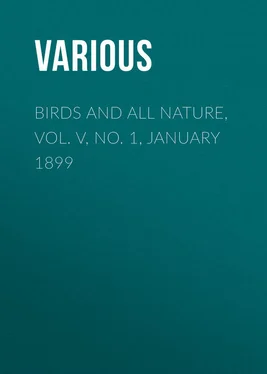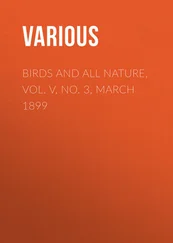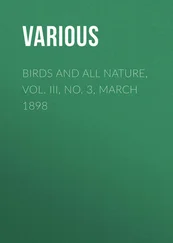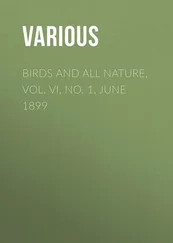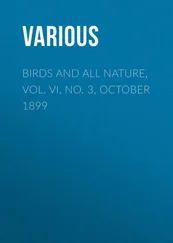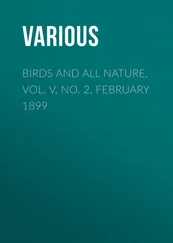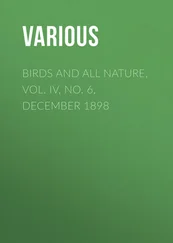Various - Birds and all Nature, Vol. V, No. 1, January 1899
Здесь есть возможность читать онлайн «Various - Birds and all Nature, Vol. V, No. 1, January 1899» — ознакомительный отрывок электронной книги совершенно бесплатно, а после прочтения отрывка купить полную версию. В некоторых случаях можно слушать аудио, скачать через торрент в формате fb2 и присутствует краткое содержание. Жанр: periodic, Биология, Природа и животные, foreign_edu, на английском языке. Описание произведения, (предисловие) а так же отзывы посетителей доступны на портале библиотеки ЛибКат.
- Название:Birds and all Nature, Vol. V, No. 1, January 1899
- Автор:
- Жанр:
- Год:неизвестен
- ISBN:нет данных
- Рейтинг книги:3 / 5. Голосов: 1
-
Избранное:Добавить в избранное
- Отзывы:
-
Ваша оценка:
- 60
- 1
- 2
- 3
- 4
- 5
Birds and all Nature, Vol. V, No. 1, January 1899: краткое содержание, описание и аннотация
Предлагаем к чтению аннотацию, описание, краткое содержание или предисловие (зависит от того, что написал сам автор книги «Birds and all Nature, Vol. V, No. 1, January 1899»). Если вы не нашли необходимую информацию о книге — напишите в комментариях, мы постараемся отыскать её.
Birds and all Nature, Vol. V, No. 1, January 1899 — читать онлайн ознакомительный отрывок
Ниже представлен текст книги, разбитый по страницам. Система сохранения места последней прочитанной страницы, позволяет с удобством читать онлайн бесплатно книгу «Birds and all Nature, Vol. V, No. 1, January 1899», без необходимости каждый раз заново искать на чём Вы остановились. Поставьте закладку, и сможете в любой момент перейти на страницу, на которой закончили чтение.
Интервал:
Закладка:
Various
Birds and all Nature, Vol. V, No. 1, January 1899
"TESS."
A REMARKABLE example of the human-like intelligence of a chimpanzee, rivaling that of the celebrated "Mr. Crowley," of New York, so long the chief object of admiration in the museum of Central Park, was that of the subject of this sketch. "Tess" was captured in Africa by Allan Grosch and brought to Boston, where she was purchased by Frank C. Bostock. She was brought up with Mr. Bostock's little girl and was dressed the same as any child of three years. She walked upright, ate with knife and fork, drank from a cup, had better table manners than the average child of the same age, wore finger-rings, ear-rings, and pin, and always surveyed herself in the glass to see that her pin was on straight, and her dress hung right; she smoked a pipe, drew lines on a blackboard, wrote with a pen, and imitated Mr. Bostock's little girl in many ways. She uttered a few sounds which were understood by her master, and seemed to understand what was said to her. She died of pneumonia while being exhibited in the East, was purchased by Mr. C. F. Gunther and presented by him to the Chicago Academy of Sciences. Her age was three years and seven months.
The chimpanzee ( Simia troglodytes ) is considerably smaller than the gorilla; old males reach a height of sixty-four inches; females, forty-eight inches. The arms are long, reaching a little below the knee, and possess great muscular power. In the feet the large toe is separated from the others by a deep incision; and the sole is flat. The hair of the chimpanzee is smooth, the color usually black, but in some specimens it is a dull, reddish brown. Chimpanzees walk on all fours, resting themselves on the calloused backs of their hands. The toes of the feet are sometimes drawn in when walking. Naturalists say there is a strong inclination in this species to show remarkably varying individual types, which has led to controversies as to whether there were not several different species.
That the chimpanzee was known to the ancients is made fairly certain by the famous mosaic picture which once adorned the temple of Fortuna, and which is said to be still preserved in the Barberini palace at Palestrina in Italy. This mosaic represents, among many other animals of the Upper Nile country, what is believed to have been the chimpanzee. A young specimen was taken to Europe in the beginning of the seventeenth century. They have been taken there repeatedly since and are not infrequent features of the European animal market. Several have been brought to the United States and placed in museums and menageries.
It was formerly believed that the chimpanzee was a gregarious animal, but it is now known that there are seldom more than five, or, at the utmost, ten living together. Sometimes, however, they gather in greater numbers for play. One observer claims to have seen at one time about fifty of them which had assembled on trees and amused themselves with screaming and drumming on the tree trunks. They shun human habitation. Their nests are built in trees, not at a great height from the ground. They break and twist and cross larger and smaller branches and support the whole on a strong bough. A nest will sometimes be found at the end of a bough, twenty or thirty feet from the ground. They change abiding places often in looking for food or for other reasons. Two or more nests are rarely seen in the same tree. Nests, properly so-called, consisting of inter-woven branches, as Du Chaillu describes, have not been seen by any of the other narrators.
When in repose the chimpanzee in the wild state usually assumes a sitting posture. He is often seen sitting or standing, but it is said the minute he is detected he drops on all fours and flees. He is an adept at climbing. In his play he swings himself from tree to tree and jumps with amazing agility. His food consists of fruits, nuts, buds, etc.
While "Tess" was remarkably intelligent she was too young to show the maturity of one in Nills' Zoological Garden in Stuttgart, an account of which is given by the celebrated painter of animals, F. Specht. This chimpanzee could laugh like a human being. He took notice of this, for no other animal can show its joy by loud laughter. When he would take the sympathetic fellow under the arms, throw him in the air and catch him, the cage rang with his merry peals of laughter. One day he took along a piece of chalk and sat down on a chair. In a moment the chimpanzee was sitting on Specht's knees awaiting further developments. He put the chalk in the animal's hand, and leading it, drew several figures on the wall. When he released the chimpanzee's hand, the animal started to shade the drawings with such diligence that they soon disappeared, to the great amusement of the spectators.
There are now, or were a few years ago, two chimpanzees in the Stuttgart zoological garden, which are the closest of friends. The female had been there before and when the male arrived his box was put over night in her warm, roomy cage the presentation being intended for the morrow. When the box, which, by the way, had been upholstered, was opened and the male got out, they both stood on their hind legs for a few minutes earnestly gazing at each other. Then they flew into each other's embrace and exchanged hearty and repeated kisses; and the female brought her blanket, spread it on the floor, sat down on it and by gestures invited the male to do likewise. It made a charming picture to see these two taking their meals at a table. They both used spoons and did not in the least interfere with each other. The female had the peculiarity of cautiously taking the male's glass, and drinking a goodly portion out of that, too, after which she returned it. Both of these animals laughed heartily when at play.
Barnum, the American showman, had two chimpanzees, "Nip" and "Tuck," on exhibition in various cities and towns, but they did not display much intelligence, nor did they live long. Other attempts to introduce the chimpanzee have not been encouraging. The experiment of keeping one has not been tried in the South, however, where there are doubtless cities whose climatic condition would prove to be favorable for keeping chimpanzees much longer than is possible in the more northern zoological collections.
WHIPPOORWILL
Hark! I hear the voice again,
Softly now and low,
When the twilight's o'er the plain
And the first stars glow.
This is what it uttereth —
In a rather mournful breath —
"Whip-poor-will! Whip-poor-will!"
What has Will been doing now?
Has he truant played
With a sad, coquettish brow
From some simple maid?
Did he steal her heart away?
For I hear you always say
"Whip-poor Will! Whip-poor Will!"
Tell me now what Will has done.
Who's to whip him, dear?
Is he some scamp full of fun
That is straying near?
Have you caught him at your nest
By the ones you love the best?
"Whip-poor-Will! Whip-poor-Will!"
That is all you seem to say,
Little bird so shy.
Tell me now, without delay,
Why whip Will, oh! why?
There! your voice fades in the lea —
Leaving this command to me,
"Whip-poor-Will! Whip-poor-Will!"
TONGUES
THE tongue is said to be the stomach begun. It is the first organ of the digestive system which acts upon the food. It is the source of much of the pleasure of life, particularly to young people. As it stands at the entrance to the alimentary canal it is endowed with powers of detecting the qualities of whatever the hands present to the stomach.
In early life the system demands abundant supplies of good material to build up growth and maintain activity. The sense of taste is then peculiarly keen, and the appetite for good things is strong. After maturity the desires become less and one has not so much pleasure in eating unless by active labor or from some other cause the digestive organs are kept in a robust condition.
Читать дальшеИнтервал:
Закладка:
Похожие книги на «Birds and all Nature, Vol. V, No. 1, January 1899»
Представляем Вашему вниманию похожие книги на «Birds and all Nature, Vol. V, No. 1, January 1899» списком для выбора. Мы отобрали схожую по названию и смыслу литературу в надежде предоставить читателям больше вариантов отыскать новые, интересные, ещё непрочитанные произведения.
Обсуждение, отзывы о книге «Birds and all Nature, Vol. V, No. 1, January 1899» и просто собственные мнения читателей. Оставьте ваши комментарии, напишите, что Вы думаете о произведении, его смысле или главных героях. Укажите что конкретно понравилось, а что нет, и почему Вы так считаете.
